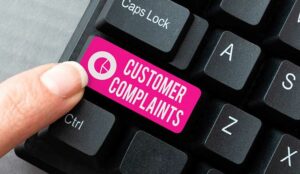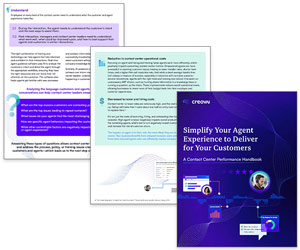We asked our panel of experts for their best advice on how to monitor customer service, to deliver an exceptional customer experience.
These are their top tips to monitor customer service:
1. Seek Out Customer Feedback
Knowing how customers perceive your business is key to your success. But it’s not always as simple as sending out a 10-point scale and comment box.
Yes, this can be a powerful tool to measure your customers’ satisfaction, but only if it’s done in the right way, and only if you’re also paying attention to what you’re missing.

To get the most out of your surveys, your customers need to know that their responses aren’t just numbers on your monthly reports.
You should engage with your customers that regularly take the time to tell you how you’re doing, and be quick to respond to valuable insights – both positive and negative.
As well as this, you should also seek out the customers who don’t tell you how you’re doing. Which customers aren’t talking to you? Take the time to communicate with customers whose opinions could shape how your business operates and look for opportunities to engage with them.
Contributed by: Bram Borne at MaxContact
2. Identify What Is Important to Customers
Numerous changes over the last two years with home-working, the accelerated growth of digital channels and greater customer expectations have impacted customer services, as well as agent well-being.
While the latter needs close attention, it does not change the core of what should be tracked to maintain the right levels of customer service. There is still a need to focus first on what is important to customers:
- How much they can self-serve
- How long they must wait for an agent
- Whether they get an answer first time
- How helpful the agent is
These are driven by several factors, for example:
- Agent training/motivation
- Resourcing levels/occupancy
- Ease of completing self-service journeys
- Accuracy of routing to agents
Therefore, a mix of customer, agent and operational metrics are needed to get a full picture and identify opportunities for improvement.
3. Have a Range of Outcome-Based Metrics

To get a complete picture of customer service requires a range of outcome-based metrics and visibility on the drivers that impact them.
For example, resolving an increasing average speed to answer (ASA) means having to know the root cause: higher-than-forecast call volumes, routing to untrained agents, or a poor self-service experience that means customers decide they want to talk to an agent.
It is quite possible all or a combination of these factors are having a simultaneous effect. So unravelling a high ASA requires additional information: call volumes, call handling times, transfers, non self-service transactions and so on.
Furthermore, resolving specific issues requires the ability to drill down, which means measures by customer type, customer intent, channel, agent team, agent skill, queue and so on.
4. Use Data to Identify Issues and Root Causes
Systems should be capturing customer interaction metadata at the lowest level to help assess performance and identify issues.
Organizations typically have real or near-real-time dashboards, but analytic capabilities are also needed to spot trends, find correlations and improve performance.
Internal data is not the be all and end all, though. There is also useful external benchmarking data. Nor should customer survey data be forgotten, or indeed anything that affects brand perception on social media and review sites (Trustpilot, Google reviews etc.) – although these may be skewed and probably cover only a small fraction of total customer interactions.
Once the data has helped identify issues and root causes, it is then key to formulate a plan to rectify them. This may include multiple aspects – people, process, system – but that’s for another discussion!
Contributed by: Steven Harris at Odigo
5. Implement a Robust Analysis Strategy

Organizations have access to customer success and agent productivity data. However, many CX leaders do not have a strategy of how to leverage and apply this data.
According to Metrigy’s recent CX Metric Gap Report, organizations should use the data in both areas in order to successfully monitor customer service.
For example, if Call Handle Time declines, but customer satisfaction also declines, this means you should allow your agents to spend more time with customers to address their problems.
The report reveals that most companies are more interested in keeping customer satisfaction high, even if it results in higher costs. Therefore it is important to analyse both customer success and agent productivity data in relation to one another.
Contributed by: Jason Griffin at Five9
6. Establish an End Goal
There’s no point in collecting data and then letting it gather dust. Before you begin monitoring customer service, you’ll need to establish what the end goal is, to know what data you need to pull out and monitor for.
If you’ve previously had issues with response times, for example, it might be worth focusing on that, or if you want to identify customer-facing bottlenecks and teething problems with team processes, you might be better off gathering information on those specific roadblocks.
That way, you know from the off that you’ll have the right data at hand, rather than reading between the lines of the data you already have.
Costa Express saw real success with this approach. By introducing a new way to measure customer experience, they were able to specifically identify the most common reasons customers made contact, allowing them to improve agent productivity and streamline processes.
7. Collate Comprehensive Data Across All Channels

Identify all the channels your customers use to contact you before monitoring for a full picture of your customer service performance.
This will help cover all bases. It might be easy to forget the channels your customers don’t use as much or those that seem a bit archaic nowadays (email and phone come to mind)
By pulling data from all your customer contact channels, you’ll be able to guarantee that you provide that critical consistency across all your contact channels and build robust omnichannel strategies.
Contributed by: Louise Newbury-Smith at RingCentral
8. Don’t Limit Analysis in One Area

NPS and CSAT are well-understood tools that have been used for a number of years. Embracing and utilizing the insights gained from these is critical in understanding bottlenecks in processes as well as areas of frustration/delight that your customers experience.
Combining technology solutions such as speech analytics with NPS/CSAT insights can yield compelling results, because you get the whole picture.
Something to be mindful of, however, is to ensure a holistic focus, not limit analysis in one area – for example, not just detractors on the NPS scale.
If you don’t see the full picture – where you are exceptional at service delivery, as well as opportunities for improvement – then you’re only getting half the story.
Contributed by: Sean McIver at MaxContact
9. Proactive Load, Usability, and Functionality Testing

My recommendation is to monitor – and eliminate – the customer service failures before your customers ever talk to an agent. Proactive load, usability, and functionality testing prevents customers from being trapped in an endless IVR loop that leaves them frustrated and furious.
It also avoids customers waiting on hold in a queue for hours before the phone line suddenly goes dead. It stops customers from finally getting through to an agent who cannot help resolve their inquiry because ‘the system is slow today’.
Independent and automated testing and monitoring technology is often overlooked but it can transform your contact centre. It can tell you exactly how many calls were dropped by your network in a typical hour, day, or week.
It can test thousands of IVR journeys before your IVR updates go live and pinpoint the cause of failure with a speed and accuracy that no human team can match! And much, much more.
Contributed by: Sandie Simms at Hammer
10. Use Real-Time and Post-Call Analytics

Analytics, enhanced by artificial intelligence capabilities, can be deployed in two ways to support an organization’s delivery of great customer service.
It can be performed in real time, allowing the system to provide in-call guidance to advisors, or it can be performed on a post-call basis, typically as part of an advisor coaching and development session.
Real-time interaction guidance monitors interactions whilst they are in progress and can help the advisor by delivering contextually relevant information that is focused on improving the delivered service.
The guidance will typically be triggered by AI models which monitor and measure items such as agent behaviours or indications of vulnerability.
In the post-call world, an advisor can either self-coach, or have a supervisor-led coaching session. All their interactions will have been analysed and simple dashboards can show examples of calls that delivered good customer service, plus those that require additional coaching.
The examples can be derived not only from the same AI models used in the real-time system, but also from calls analysed for compliance to all internal (and external) customer service standards.
These two complementary approaches mean that an organization is creating a work environment where the analytics solution is supporting all advisors to deliver the best possible customer service.
Contributed by: Andy Traba at NICE
11. Use Social Media Tools
Social media is now the first thing most customers see and the most easily accessible. Social is not only the face but the command and messaging centre of your business as far as most customers are concerned.
Monitoring and remaining active on social are vital to successful CX. Originally created to simply manage multiple social media platforms in one place, monitoring tools, hubs and platforms possess a value that far exceeds the original management need.
With most companies devoting a huge share of marketing focus and money to social media, it’s the easiest but also the most time-consuming way to track the conversations and pay attention to trends. Some things to watch:
- Hashtags (organic and user-generated, as well as industry, conference and meet-up hashtags)
- Your C-Level executives and officers
- Your promoters and influencers
- Videos and how-tos
- Product mentions and usage
- Competitors
12. Gather Customer Feedback
How do you know what customers think? Give your end user an outlet and they’ll tell you. Along with the understanding that customers can promote, demote, shame and champion a brand, customers also know and leverage the idea that they can effect change within a business or an industry.
Customer feedback is more valuable than ever. With an increasing number of channels, platforms and tools available for customers to respond, they value the ability to rate and recommend their experiences.
Surveys are great for this. But there’s multiple opportunities for you to build a user interface that encourages your customers to leave feedback via multichannel.
Whether it’s a simple splash page, text survey, or voice memo, it’s important to design these feedback mechanisms not just to capture what you want to know, but to permit the customer to tell you what they want you to know.
13. Connect Customer Data Points

Customer experience is defined by all the customer interactions across a variety of channels and touchpoints. Happy fans are great, but fans, followers, voices and trends have little impact if they can’t be directly connected to customer data points.
With multichannel and infinite touchpoints, it’s easy to confuse noise with signal. Analytics cut through the noise without muffling the sound.
Behavioural, sales, market and search analytics are just a few tracks that help you identify what part of the customer experience is getting reinforced and what part is getting lost in the clouds.
Collecting the dots of your customer has to lead to the connection of dots between actual behaviour, money spent, market need and market metrics.
14. Make the Most of Your CRM
Your CRM manages the relationship between your company and the customer. It’s an easy and effective way to ensure that each of your customers has a voice to be heard.
CRMs were designed to pull enormous amounts of data for an overall assessment or massive data points for campaigns, so it’s important to understand that a CRM is also capable of maintaining the details of individual customers so as to track, record, and provide some historical context in an instant.
With so many routes of access and touchpoints available, tracking CX and monitoring satisfaction levels can be tricky.
By using your tools and platforms efficiently and thoughtfully, you are not only able to take a snapshot of your customer experience at any point and time, but also to tell a story and control the CX narrative, with the goals of obtaining actionable insights and constant customer satisfaction.
Contributed by: Kaye Rickards at Alvaria
15. Use Voice of the Customer (VoC) Data
VoC insights are everywhere. Conversation data, social media, third-party review sites, customer surveys – the list goes on. However, the inability to distil this feedback, identify prominent trends and build a rich store of actionable insights often prevents contact centre teams gaining accurate customer perspectives of service experiences.
Fortunately, AI advancements are paving the way for VoC solutions that gather data before transforming, analysing and visualizing it. As such, companies can unearth trends, spot pain points and predict customer needs.
Perhaps most importantly, these visualizations enable businesses to see the stories that the data tells, recognize improvement opportunities and identify challenges in systems and processes.
With this powerful view of customer insights, companies can wrap context around the numbers and challenge biases. Doing so is critical as analysts must maintain an open mind and avoid fitting the numbers around preconceived ideas. After all, storytelling is no substitute for analysis.
16. Combine Speech Analytics and Desktop Monitoring
Unlock the Voice of the Customer (VoC) with speech analytics and turn raw customer interactions data into relevant and readily available usable insights.
Consider using speech analytics to analyse and identify the most relevant calls for quality assurance purposes quickly and accurately, or to get a good sense of what your customers need from you.
Imagine you could put all of your agents into a room, and they just told you all of the hot topics of the day. That is the power of speech analytics.
Imagine you could put all of your agents into a room, and they just told you all of the hot topics of the day. That is the power of speech analytics.
Combine speech analytics with desktop monitoring to understand agent effectiveness and drive agent productivity by determining which resources they use and which of their activities are productive vs. unproductive.
When used in conjunction with other metrics that gauge agent effectiveness – such as average quality evaluation score, the number of positive sentiment calls received or agent adherence – desktop monitoring adds a powerful new dimension to monitoring customer service.
17. Harness Quality Management Tools
Every customer conversation offers an opportunity to enhance customer loyalty. Recognizing this, quality analysts manually score calls and transcripts, highlighting opportunities to improve agent behaviours and secure better customer outcomes.
Yet, providing a formal quality management programme across a large operation is often difficult. Many analysts struggle to isolate individual trends over time, calibrate scoring, and create a system that agents buy into and believe is fair.
Inviting agents to calibration sessions – where analysts score calls to develop consistency – helps. However, to go further, harness the calibration function within quality management solutions, which give agents the chance to challenge scores.
When activated, the analyst rescores the call with the agent and they discuss discrepancies. Such a function opens a coaching culture powered by open conversations, allowing companies to monitor service in a way that seems fair to agents and benefits customers.
18. Track Employee Engagement

Happy employees = happy customers is an old adage. Unfortunately, it is not always true. For instance, a shop assistant who stares at their phone all day may enjoy their job. However, their service is likely to be underwhelming.
So, let’s rephrase the saying: engaged employees = happy customers. Perhaps it is not as catchy, but it is much more accurate as contact centre agents who strive to do their best for customers most often deliver the right results.
Alongside this mindset shift, consider how best to measure engagement. It is not an isolated quarterly agent satisfaction survey. Of course, agent happiness is crucial, but this must correlate with monitoring customer service and improvements in customer engagement metrics.
Analytics-enabled employee engagement combined with quality management move monitoring beyond a specific agent and customer transaction towards a comprehensive customer service monitoring.
An AI analytics-enabled system provides a bird’s-eye view of interactions so you can evaluate 100% of customer contacts, regardless of channel.
19. Have Visibility on Real-Time Agent Activity
Build multiple reports onto the same screen to understand real-time agent activity, queues, and the progress of active contacts in a glance. This capability is particularly valuable in hybrid environments, enhancing remote agent management strategies.
Connecting siloed data from an array of tools – including ACD, CRM, IVR – is central to this strategy. Yet, on-premise contact centre solutions – which may differentiate CX – are tricky to integrate. As a result, operations often fail to generate the necessary flow of customer data.
These data management struggles are evident in an Aberdeen Group study, highlighting that only 13% of companies are happy with their ability to use data to improve customer interactions.
Thankfully, business intelligence systems provide the ideal platform for managers to extract relevant customer information and channel insights to agents. In doing so, they combine and synchronize interaction data, streamline business processes, and single a central source of CX truth.
Contributed by: Dave Hoekstra at Calabrio
20. Listen to Your Customers

Providing great customer service starts with listening to your customers. And that means being able to listen to them across all forms of channels and communications, including email, text, webchat and social media.
Being able to understand customer feedback within these channels is a key differentiator when monitoring customer service.
To listen to your customers, consider an analytics solution. The technology can mine through masses of data, ‘listening’ to all calls and forms of communication, rather than just a random sample. This helps to spot predefined keywords and expressions that might indicate problem areas, such as mentions of competitors or words typically associated with customer complaints.
What’s more, a personalized analytics dashboard can help make sense of this customer data as well as monitor KPIs such as average handle time (AHT), supervisor escalations, compliance violations and customer satisfaction scores.
Contributed by: Alex Stenton-Hibbert at Business Systems
21. Take an Omnichannel Approach

Customer expectations are continuing to increase with a rise in demand for seamless and personalized experiences.
The move to a customer-first approach is why it’s important to know how your agents are representing the company in conversations, and the level of service they are providing.
Due to time constraints and high call volumes, it is an impossible task to manually monitor all interactions and provide first-time resolution on issues and challenges that are arising.
Because of this, automated tools are changing the way organizations can monitor interactions at scale and gain insights into conversations across all channels. This can include social media mentions, review sites as well as calls and online chat.
This omnichannel approach can help organizations to have a complete bird’s-eye view on how customer service is being delivered.
For example: organizations can be alerted when a recurring topic is being discussed, if agents are providing the right information at the right time, and even where additional coaching might be needed.
Contributed by: Frank Sherlock at CallMiner
22. Analyse Your Customers’ Spoken Words

Speech analytics solutions provide an opportunity to monitor the customer experience and discover better ways of working with customers.
Speech analytics works by detecting trends based on programmed keywords and phrases as well as variations in pitch, silences and emotions, offering a complete picture of what customers think about your service.
As a result, the solution provides the ultimate tool for listening to your customers’ pain points and making improvements that can improve the customer experience and increase sales.
Even when agents handle hundreds of calls every day, speech analytics will help you gauge satisfaction levels, allowing you to introduce pre-emptive actions that ensure your customers return.
If you have the capability in place to analyse your customers’ spoken words, you can identify what they care about, categorize key topics and find out what processes are broken.
This, in turn, will offer your businesses the operational intelligence to fix issues before they escalate while helping you retain your customers.
Contributed by: David Evans at Vonage
23. Use Automated Testing to Identify Call Quality Issues
Poor voice quality affects as many as 30 percent of all incoming contact centre calls, manifesting as latency, static, ambient noise, and more. Problems may begin as early as interactive voice response (IVR).
If customers can’t hear or understand the options, they’re more likely to ask for a live agent. Then, voice quality issues can affect customer–agent conversations, increasing average handling time for calls by up to 27 percent.
Alternatively, customers may hang up and call again, negatively impacting first-time resolution rates. For an EMEA contact centre receiving 200K calls a day, this could mean €5.8M in lost labour per year.
Fortunately, contact centres can use automated testing services to identify call quality issues, such as software and hardware incompatibility, poor cell signals, and bandwidth constraints.
Testing services provide end-to-end, bidirectional assessments of call quality, enabling contact centre leaders to quickly zero in on the cause of issues. They can then use this data to make fast, targeted improvements for a better call experience.
24. Regularly Test IVRs
IVR downtime can wreak havoc on contact centre operations, overloading other channels such as calls, chat, emails, and more.
Call containment is the holy grail of EMEA contact centre operations. AI-driven interactive voice response (IVR) costs just 38 to 57 cents. That’s why companies invest so much in IVR: from designing great scripts, to testing pathways to make sure they are easy to follow and answer customer questions.
Automated testing can identify issues, either before new IVR systems are put into production or as they occur, enabling fast, effective resolution.
IVR downtime can wreak havoc on contact centre operations, overloading other channels such as calls, chat, emails, and more.
For example, Vodafone New Zealand significantly decreased IVR downtime by using automated testing to perform daily checks on IVRs before business hours.
Testing data flows through to the company’s ticketing application, enabling faster resolution. Now, 100 percent of networks are monitored, and most issues are solved before they impact customers.
25. Review SMS Journeys
For contact centres, the growth of SMS has proven to be a boon. Text updates enable agents to instantly acknowledge customers and use standard response templates to support more interactions.
Customers are more responsive, too, as they read 99 percent of all texts and 95 percent within just three minutes.
In addition to handling inbound queries, companies can use outbound SMS for all manner of notifications, such as providing notices of product availability, enabling troubleshooting support, sending appointment reminders, asking for survey feedback, and more.
To reap full value from these investments, companies should automatically test SMS journeys to make sure they perform as expected and integrate effectively with other channels, such as phone and web channels. By so doing, companies can capitalize on this growing and cost-effective channel.
26. Test Omnichannel Customer Journeys
Customers use various tools as they seek to resolve their issues. They may search corporate knowledge bases, then initiate a text or chat session if they can’t find the information they want.
Other customers may move from chatbots to interactive voice response (IVR) and then a live agent if they can’t get their needs met. The truly impatient may use multiple channels at once, playing the odds on which one will pan out first.
As a result, companies that use contact centres need to test omnichannel customer journeys, searching for broken links that can impede customers’ seamless progress across channels.
Automated testing can replicate customer journeys that span and hop channels or require callbacks and confirmations. Even better, results are generated as a single test case, enabling customer experience teams to quickly drive to insight on what they need to do to optimize processes.
Contributed by: Cyara
27. Review and Score Customer Interactions

Customer service monitoring has been around for decades. Monitoring is now much wider than voice conversations alone, businesses need the ability to review digital customer interactions emails, text messages, support tickets and so on.
Completing quality reviews on interactions between your business and your customer base is crucial for delivering first class customer service, as is rewarding your staff for doing a great job.
You need to review customer interactions, score them, provide feedback, and calibrate your quality analysts, supervisors and managers so they all grade interactions equally and therefore fairly. This is just the tip of the iceberg.
Providing staff mentoring and coaching to improve the way they deal with your customers, coupled with a learning system that not only helps on board and train staff faster, allows you to provide ongoing education, and support to the team.
Rewarding staff for doing a great job is essential if you want to exceed customer expectations. This is very much about the culture you want to build and maintain within any customer-facing organization.
You should also put metrics in place and review interactions to reduce response times, improve First Contact Resolution and reduce repeat contacts.
Contributed by: Lee Cottle at Playvox
28. Unify Systems to Improve Access and Visibility

Customers want excellent service using their channel of choice, while contact centre agents need the right tools and the ability to work from anywhere to deliver it.
Today, organizations of all sizes need to connect customers with the right agent or representative, regardless of where they’re located, to deliver the best possible customer experience.
Integrated systems allow organizations of all sizes to meet, monitor, and exceed customer expectations by presenting customers with the right agent or representative – who has immediate access to the right information – at the right time.
Identifying and eliminating communication siloes, and having access to a complete view of the customer journey allows businesses to deliver the personalized, efficient experiences that their customer base has come to expect.
What’s more, they are able to optimize agent and employee performance using fully integrated analytics, coaching, and collaboration tools that are perfect for today’s remote and hybrid work environments.
Contributed by: Janice Rapp at 8×8
29. Expand the Data Available

I find this topic very interesting. In many ways we have it nailed, and in others we are way off the mark.
Of course, we all know we can use links, SMS, IVR, QR, web widgets, POS, kiosk, email, written survey, online survey etc.
These are all tuned to our sector and need, but the data is highly skewed and typically represents a small subset sample centred around known topics and issues for categorization.
In precis, we see most service surveys weighted towards success and management infrastructure and incapable of digitally tracking or capturing unknown topics other than in free text fields.
AI and NLU technologies have a major part to play in next-generation S-SAT/CX /customer journey and service.
Contributed by: Andrew White at Contexta360
30. Define Customer Service
To exceed expectations, it is important to define customer service as both digital and human-assisted interactions with an organisation.
Over 80% of customers interact with a search engine or an organisation’s website before ever reaching a human-assisted channel such as chat or voice calls.
To ensure acceptable service levels, omnichannel interaction analytics across all of these channels, on 100% of digital and voice interactions, with post-interaction, intra-day, and real-time metrics is a critical first step.
This puts all interaction data in one place for accurate analysis and visualisation by any KPI, separated by channels or all together, through the lens of team and individual performance, and so on.
Multi-channel analytics is the first step – but visualising key metrics and communicating them to stakeholders across the organization is what makes it possible for all roles to take a multi-faceted and proactive approach that delights customers on every channel.
31. Combine Metrics, Technologies and Processes

Today’s customer service occurs in phases and involves multiple channels. Pre-contact, key technologies such as search engine, knowledge base, and mobile app optimisation make it easy to find information with options to self-serve.
Should these channels not suffice, conversational AI chatbots and optimised IVR systems can help customers self-serve.
When they make contact, ensure an effortless experience with AI routing, contextual customer data points and real-time interaction guidance to help agents personalise each interaction while managing an efficient, positive customer experience.
Monitor key metrics such as sentiment, first contact resolution, and agent behaviours proven to drive customer satisfaction.
Send contextual post-interaction surveys and encourage customers to provide feedback in their own voice.
Lastly, gather all this data and analyse it for opportunities to improve experiences, empower agents to exceed expectations, and proactively reach out to any customer who had a negative experience to turn their frustration into lasting loyalty.
Contributed by: Abby Monaco at NiCE
For more great suggestions from our industry experts, read these articles next:
- What Are the Key Call Centre Technologies?
- Performance Management Best Practices
- 21 Steps to a More Personalized Customer Experience
Author: Robyn Coppell
Reviewed by: Rachael Trickey
Published On: 20th Jun 2022 - Last modified: 13th Oct 2025
Read more about - Customer Service Strategy, 8x8, Alex Stenton-Hibbert, Alvaria, Andrew White, Andy Traba, Business Systems, Calabrio, CallMiner, Contexta360, Customer Service, Cyara, Dave Hoekstra, Five9, Frank Sherlock, Hammer, Jason Griffin, Lee Cottle, MaxContact, Monitoring, NiCE, Odigo, Playvox, RingCentral, Sean McIver, Service Strategy, Steven Harris, Vonage




















